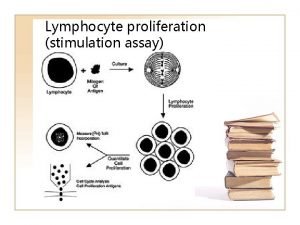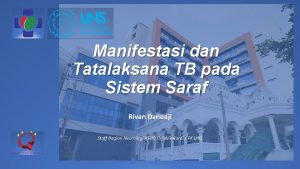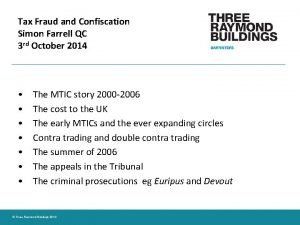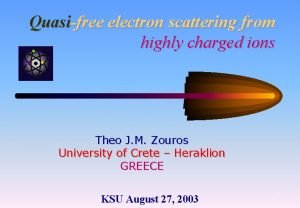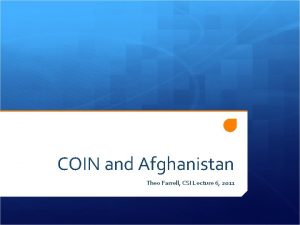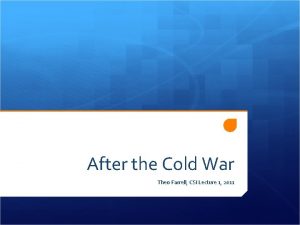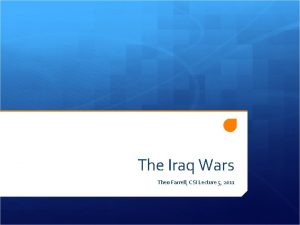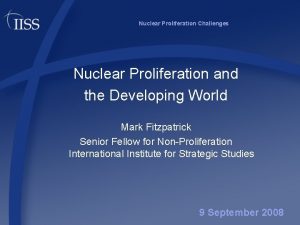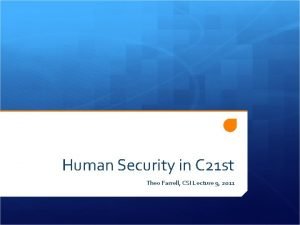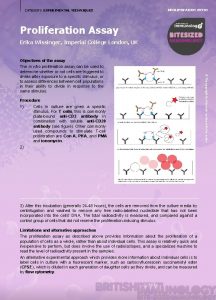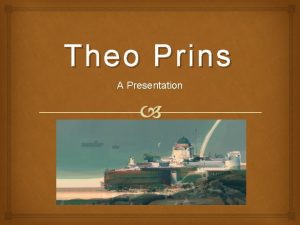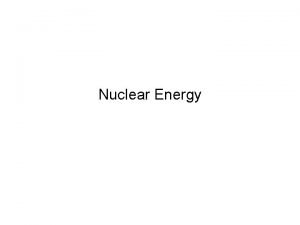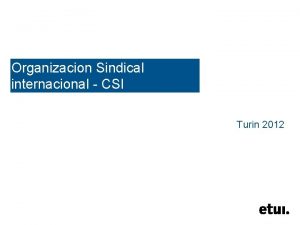Nuclear Proliferation Theo Farrell CSI Lecture 4 2011





















- Slides: 21

Nuclear Proliferation Theo Farrell, CSI Lecture 4, 2011

Weapons of Mass Destruction Nuclear Biological Chemical Radiological

Big bombs Fissile material = plutonium 239 and uranium 235 Fission warhead = kilotons TNT Fusion warhead = megatons TNT

Dawn of the nuclear age ‘Anglo-Saxon science has developed a new explosive 2, 000 times as destructive as any know before For all we know, we have created a Frankenstein! We must assume that with the passage of only a little time, an improved form of the new weapon we use today can be turned against us. ’ NBC Radio, August 1945

The nuclear revolution ‘Thus far the chief purpose of our military establishment has been to win wars. From now on its chief purpose must be to avert them. It can have almost no other useful purpose. ’ Bernard Brodie (1946)

Weapons of terror ‘There is an immense gulf between the atomic and hydrogen bomb. The atomic bomb, with all its terrors, did not carry us outside the scope of human control or manageable events in thought and action, in peace and war. But (with the H-bomb), the entire foundation of human affairs is revolutionized, and mankind placed in a situation both measureless and ladden with terror. ’ Winston Churchill (1955)


Nuclear armed states NPT Date Warheads Non-NPT Date Warheads Russia 1949 4650 (12000) Israel 1966 80 US 1945 2468 (9600) France 1960 300 Pakistan 1998 100 -110 China 1964 180 (240) India 1974 60 -80 UK 1952 <160 (225) North Korea 2006 <10

International co-operation Partial Test Ban Treaty, 1963 Non-proliferation Treaty (NPT), 1968 Comprehensive Test Ban Treaty, 1996 Convention on Physical Protection of Nuclear Material, 1987 Fissile Material Cut-off Treaty, under negotiation G 8 Global Partnership against Spread of Weapons and Materials of Mass Destruction

NPT pillars 1. Non-proliferation – undertake not to ‘receive, manufacture or acquire’ nukes (Art. II) – monitoring by IAEA 2. Disarmament – non-binding obligation on P 5 (Art. VI) 3. Peaceful use of nuclear energy – the ‘Achilles heal’ of NPT? * Right to withdraw from NPT (Art. X)

Why build nuclear weapons? 1. The security model (Soviet Union) 2. The domestic politics model (India) 3. The norms model (France) Scott D. Sagan, ‘Why do states build nuclear weapons? ’ Int. Security 21: 3 (1996/97).

Should we worry? Kenneth Waltz Neorealism – nukes make states cautious spread of nukes is okay Scott Sagan Organisation theory and nuclear accidents States cannot be trusted with nukes

More reasons to worry… Emerging nuclear powers tend to have small and rudimentary nuclear forces that are: Vulnerable to first-strike Vulnerable to accidents Vulnerable to unauthorised seizure

Nuclear alarmism – myths 1. End of Cold War increased incentives for proliferation – world has now reached ‘tipping point. ’ 2. Second Nuclear Age is less predictable and involves more complex and dangerous rivalries 3. Today’s ‘rogue’ states and terrorist organisations are less deterrable than Cold War rivals

Iran’s Nuclear Program IAEA in 2003 find Iran in breach of NPT Iran halts nuc prog but Western intell agencies disagree on how long NIE 2007: Iran’s program still stalled US Director Nat Intell (Feb 2010): Iran able to produce weapon in next few years


Nightmare scenario

Israel’s track record (Iraq 1981)

Indo-Pak India: 5 nuke tests on 11 & 13 May 1998 Pakistan: 6 nuke tests on 30 & 31 May 1998 Indo-Pak Wars (1947 -48, 1965, 1971 and 1999) and dispute over Kashmir


‘Stability/instability paradox’ Pakistani supported terrorist attacks on Indian Parliament (Dec 2001) and Mumbai (Nov 2008) India’s new ‘Cold Start’ military doctrine: five divisions in 96 hours Pakistani’s ‘flexible response’ nuclear posture
 Lesson 15 nuclear quest nuclear reactions
Lesson 15 nuclear quest nuclear reactions Fisión nuclear vs fision nuclear
Fisión nuclear vs fision nuclear Fibrous proliferation
Fibrous proliferation Arahnoidalna cista
Arahnoidalna cista Uncontrolled clonal proliferation
Uncontrolled clonal proliferation Lymphocyte proliferation
Lymphocyte proliferation Intimal proliferation
Intimal proliferation Industrial proliferation
Industrial proliferation Proliferation of advertising example
Proliferation of advertising example Folliculocentric basaloid proliferation
Folliculocentric basaloid proliferation Hodgkin's lymphoma
Hodgkin's lymphoma Proliferation of interest groups
Proliferation of interest groups Byron farrell
Byron farrell Christ be our light
Christ be our light Farrell bag troubleshooting
Farrell bag troubleshooting Simon farrell qc
Simon farrell qc Kelly farrell
Kelly farrell Stacy o'farrell santa cruz
Stacy o'farrell santa cruz Who is farrell jarreau
Who is farrell jarreau 01:640:244 lecture notes - lecture 15: plat, idah, farad
01:640:244 lecture notes - lecture 15: plat, idah, farad Theo ion
Theo ion Theo de jager poet biography
Theo de jager poet biography





